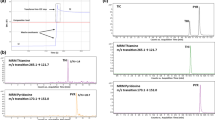Abstract
A novel, cheap and simple method for the determination of 10B and 11B mole fractions in 10B enriched boron compounds by capillary zone electrophoresis with indirect UV detection was developed. The background electrolyte contained 35 mM phenylalanine adjusted to pH of 8.8 with putrescine. The running conditions were + 25 kV at 34° C. Indirect photometric detection was performed at 210 nm. The analysis time was less than 17 min. The interday RSD of migration times and peak areas were less than 0.9% and 2.3%, respectively (n = 18). Linearity was demonstrated in the range 0.3–15 mM for both isotopes. Analysis of boron compounds with mole fraction of 10B ranging from 19.8 (natural abundance) up to 90.0% was successfully demonstrated.




Similar content being viewed by others
References
Miyatake S, Kawabata S, Hiramatsu R, Kuroiwa T, Suzuki M, Kondo N, Ono K (2016) Boron neutron capture therapy for malignant brain tumors. Neurol Med Chir 56:361–371
Hsu CF, Lin SY, Peir JJ, Liao JW, Lin YC, Chou FI (2011) Potential of using boric acid as a boron drug for boron neutron capture therapy for osteosarcoma. Appl Radiat Isot 69:1782–1785
Ono K, Masunaga S, Suzuki M, Kinashi Y, Takagaki M, Akaboshi M (1999) The combined effect of boronophenylalanine and borocaptate in boron neutron capture therapy for SCCVII tumors in mice. Int J Radiat Oncol Biol Phys 43:431–436
Ono K, Kinashi Y, Masunaga S, Suzuki M, Takagaki M (1998) Effect of electroporation on cell killing by boron neutron capture therapy using borocaptate sodium (10B-BSH). Jpn J Cancer Res 89:1352–1357
Leusch A, Jungblut PW, Moroder L (1994) Design and synthesis of carboranyl peptides as carriers of 1,2-dicarbadodecarborane clusters. Synthesis 3:305–308
Coplen TB (2002) Isotope-abundance variations of selected elements. Pure Appl Chem 74:1987–2017
Rao RM, Parab AR, Sasibhushan K, Aggarwal SK (2009) A robust methodology for high precision isotopic analysis of boron by thermal ionization mass spectrometry using Na2BO2+ ion. Int J Mass Spectrom 285:120–125
Rao RM, Parab AR, Sasibhushan K, Aggarwal SK (2008) Studies on the isotopic analysis of boron by thermal ionisation mass spectrometry using NaCl for the formation of Na2BO2+ species. Int J Mass Spectrom 273:105–110
Kamencev M, Yakimova N, Moskvin L, Kuchumova I, Tkach K, Malinina Y (2016) Fast isotopic separation of 10B and 11B boric acid by capillary zone electrophoresis. Electrophoresis 37:3017–3019
Urey HC (1947) The thermodynamic properties of isotopic substances. J Chem Soc. https://doi.org/10.1039/jr9470000562
Bigeleisen J, Mayer MG (1947) Calculation of equilibrium constants for isotopic exchange reactions. J Chem Phys 15:261–267
Terabe S, Yashima T, Tanaka N, Araki M (1988) Separation of oxygen isotopic benzoic acids by capillary zone electrophoresis based on isotope effects on the dissociation of the carboxyl group. Anal Chem 60:1673–1677
Bushey MM, Jorgenson JW (1989) Separation of dansylated methylamine and dansylated methyl-d3-amine by micellar electrokinetic capillary chromatography with methanol-modified mobile phase. Anal Chem 61:491–493
Lucy CA, McDonald TL (1995) Separation of chloride isotopes by capillary electrophoresis based on the isotope effect on ion mobility. Anal Chem 67:1074–1078
Yeung KK, Lucy CA (1998) Isotopic separation of [14N]- and [15N]aniline by capillary electrophoresis using surfactant-controlled reversed electroosmotic flow. Anal Chem 70:3286–3290
Yeung KK, Lucy CA (1999) Ultrahigh-resolution capillary electrophoretic separation with indirect ultraviolet detection: isotopic separation of [14N]- and [15N]ammonium. Electrophoresis 20:2554–2559
Aupiais J (2011) Electrophoretic mobilities of the isotopes of chloride and bromide ions in aqueous solution at 25 °C and infinite dilution. J Solution Chem 40:1629–1644
Kamencev M, Yakimova N, Moskvin L, Kuchumova I, Tkach K, Malinina Y, Tungusov O (2015) Isotopic separation of lithium ions by capillary zone electrophoresis. Electrophoresis 36:3014–3017
Reijenga JC, Gagliardi LG, Kenndler E (2007) Temperature dependence of acidity constants, a tool to affect separation selectivity in capillary electrophoresis. J Chromatogr A 1155(2):142–145
Johns C, Macka M, Haddad PR (2003) Enhancement of detection sensitivity for indirect photometric detection of anions and cations in capillary electrophoresis. Electrophoresis 24:2150–2167
Beckers JL (1999) Transfer ratio in indirect UV detection in capillary zone electrophoresis—a mathematical approach. J Chromatogr A 844(1–2):321–331
Erny GL, Esteves VI (2009) Robustness of the co-ion transfer ratio in capillary electrophoresis. J Sep Sci 32(17):3007–3012
Manov GG, DeLollis NJ, Acree SF (1944) Ionization constants of boric acid and the pH of certain borax-chloride buffer solutions from 0° to 60° C. J Res Natl Bur Stand 33:287–306
Nagai H, Kuwabara K, Carta G (2008) Temperature dependence of the dissociation constants of several amino acids. J Chem Eng Data 53:619–627
Sah RN, Brown PH (1997) Boron determination—a review of analytical methods. Microchem J 56:285–304
Funding
This work was supported by the Russian Science Foundation (Project 16–13-10117).
Author information
Authors and Affiliations
Corresponding author
Ethics declarations
Conflict of Interest
The authors have no conflicts of interest to declare that are relevant to the content of this article.
Availability of Data and Materials (Data Transparency)
Not applicable.
Code Availability (Software Application or Custom Code)
Not applicable.
Additional information
Publisher's Note
Springer Nature remains neutral with regard to jurisdictional claims in published maps and institutional affiliations.
Rights and permissions
About this article
Cite this article
Malinina, Y., Yakimova, N., Moskvin, L. et al. A Low-Cost, Simple Method for Isotopic Analysis of Enriched Boron Pharmaceutical Substances by Capillary Zone Electrophoresis with Indirect UV Detection. Chromatographia 84, 393–398 (2021). https://doi.org/10.1007/s10337-020-03995-9
Received:
Revised:
Accepted:
Published:
Issue Date:
DOI: https://doi.org/10.1007/s10337-020-03995-9




